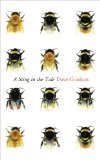 Shortlisted for 2013 Samuel Johnson Prize for Non-Fiction
Shortlisted for 2013 Samuel Johnson Prize for Non-Fiction
Five words from the blurb: bumblebee, expert, protect, research, dangers
I picked up a copy of this book because the author was planning to talk at my local library. I didn’t have a particular interest in bees, but Dave Goulson is an inspiring man and he’s made me look at them in a new light.
The author is a Professor of Biological Sciences at the University of Sussex and has published over 200 scientific articles on the ecology of bees and other insects. A Sting in the Tale is a witty, accessible book that summaries most of what is known about bumblebees today.
The book is packed with amusing anecdotes about the difficulties of studying bees; whilst also giving sound scientific information about the problems facing their population in the UK today. It is one of those wonderful books that enables someone with limited knowledge on a subject to understand and become fascinated by something they’d normally overlook. I had no idea that bumblebees are necessary to pollinate tomatoes and a whole industry has been set up to produce commercial bumblebee nests, which are then shipped to tomato glasshouses around the world:
The only tomato growers left out of the bumblebee bonanza were those in Australia, where there are no native bumblebees, and where importing foreign species is strictly forbidden. Tomato growers on mainland Australia still have to hand-pollinate their plants; teams of workers are employed, each of whom is equipped with a slender vibrating wand. Every flower has to be touched with the tip of a wand if it is to set fruit. As might be imagined, this is tedious work in a large glasshouse – some commercial operations cover hundreds of acres and contain literally millions of tomato flowers – and the labour costs are substantial.
I also knew nothing about the problems this creates with the spread of disease and the hybridisation of native species. I discovered that I knew far more about the problems facing honeybees than those of bumblebees and am pleased I’ve now rectified this situation.
The only problem is that this book concentrates on bees in the UK. Much of the information will be interesting to those in other countries, but those wanting to know specific information about bumblebee species in other parts of the world will probably be frustrated.
It would also have been nice to see photos/charts to enhance the information given. The presentation at my library included a lovely selection of images and it would have been nice to see these in the book.
A Sting in the Tale is a very important book. Many species of bumblebee in the world are facing extinction and I don’t think many people realise this, or how important they are. I urge you to read this book and I hope that the Bumblebee Conservation Trust goes from strength to strength.

.

7 replies on “A Sting in the Tale by Dave Goulson”
Oo, fascinating! I’m especially interested in Australia’s difficulties. Does New Zealand have a similar problem with bumblebees? I know they have very strict laws as well about bringing non-native species into the country.
I like tomatoes and all, but if I were Australia, I might just learn how to live without them. Lots of meals can happen without tomatoes. That sounds like the most tremendous nuisance and hassle.
Jenny, Great question! The book talks a lot about New Zealand and the problems it has faced since some British bumblebees were introduced 100? years ago. I’m not sure the Australians are ready to give up tomatoes – I think I’d prefer to hand pollante a few in my garden than go without completely.
I had no idea that some cultivated plants in some parts of the world still have to be hand-pollinated! That’s fascinating. And like you, I’ve heard more about the decline of the honeybee than of the issues facing bumblebees.
Christy, Apparently it is getting increasingly common as there aren’t enough bumblebees to go around. It is amazing that these things aren’t general knowledge!
[…] A Sting in the Tale by Dave Goulson […]
[…] A Sting in the Tale by Dave Goulson […]
I want this book! LOL Yes, indeed, I am learning what I can about bees, I seem to be fascinated by them (even while dreading their sting). Most of my garden is planted for bees and butterflies, and my daughter and I noticed last year that the bees were slow in coming here, though by August we did have bumblebees around. I am so sad that their population is declining. Thanks for the rec, I missed it on Nan’s blog.